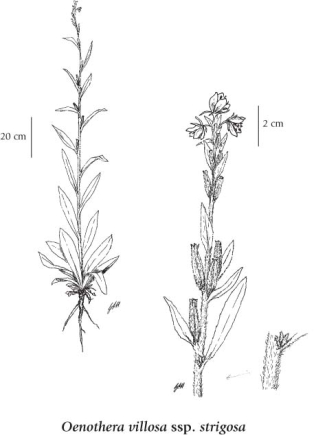Oenothera villosa subsp. strigosa Thunb. (Rydb.) W. Dietr. & P.H. Raven
yellow evening-primrose (hairy evening-primrose)
Onagraceae (Evening Primrose family)
Introduction to Vascular Plants
yellow evening-primrose (hairy evening-primrose)
Onagraceae (Evening Primrose family)
Introduction to Vascular Plants
Map
Distribution of Oenothera villosa subsp. strigosa
Click here to view the full interactive map and legend
Species Information
General:
Biennial herb from a stout taproot; forming rosette in first year and an erect, stiff stem in second; greyish stiff-hairy, also with spreading hairs from red blister-like bases; stems 50-200 cm tall, simple or branched.
Leaves:
Stem leaves alternate, ascending or spreading, lanceolate or elliptic, 10-30 cm long, entire to minutely-toothed, hairy.
Flowers:
Inflorescence a few-flowered, open spike, glandular, buds erect, opening in the evening, subtended by large bracts or reduced leaves; hypanthium 2.5-4 cm long; petals yellow, fading duller or pale orange, 0.7-2 cm long; sepals 0.9-1.8 cm long, often marked reddish, bent back when in flower, the free tips in bud 0.5-2.5 mm long.
Fruits:
Capsules, erect, narrowly lanceolate, 2-3.5 cm long, 4-7 mm wide, more or less straight, 4-chambered, hairy; seeds 1-2 mm long, angled, irregularly pitted.
Illustration

If more than one illustration is available for a species (e.g., separate illustrations were provided for two subspecies) then links to the separate images will be provided below. Note that individual subspecies or varietal illustrations are not always available.
Illustration Source: The Illustrated Flora of British Columbia
Habitat and Range
Dry shrubland, roadsides and disturbed areas in the lowland and steppe zones; infrequent in C and S BC east of the Coast-Cascade Mountains, rare along the coast, where probably introduced; E to ON and S to MI, WI, NE, NM, AZ and CA.Synonyms
Synonyms and Alternate Names:
Oenothera biennis var. strigosa (Rydb.) Piper
Oenothera cheradophila Bartlett
Oenothera depressa subsp. strigosa (Rydb.) Roy L. Taylor & MacBryde
Oenothera procera Woot. & Standl.
Oenothera rydbergii House
Oenothera strigosa (Rydb.) Mack. & Bush
Oenothera strigosa subsp. cheradophila (Bartlett) Munz
Oenothera villosa subsp. cheradophila (Bartlett) W. Dietr. & Raven
Oenothera villosa var. strigosa (Rydb.) Dorn
